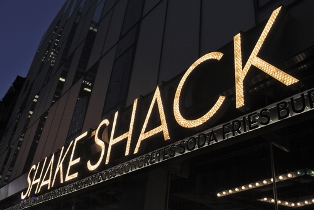It looks like a Shake Shack IPO could hit the market in late 2014 or early 2015, after last week's news that the company selected underwriters for its public offering. Reuters reported last Thursday that Shake Shack selected JPMorgan Chase & Co. (NYSE: JPM) and Morgan Stanley (NYSE: MS) as lead underwriters for the IPO.
 Shake Shack was founded in 2004, when owner Danny Meyer opened a kiosk-style restaurant in New York's Madison Square Park. The chain has developed a loyal following for its "Shackburgers," "Flat-Top" hot dogs, and namesake milkshakes, with customers sometimes waiting in line for more than an hour during peak times.
Shake Shack was founded in 2004, when owner Danny Meyer opened a kiosk-style restaurant in New York's Madison Square Park. The chain has developed a loyal following for its "Shackburgers," "Flat-Top" hot dogs, and namesake milkshakes, with customers sometimes waiting in line for more than an hour during peak times.
Meyer had originally planned on just opening the one location, and five years passed before the company opened a second spot. Now, the chain operates 46 locations in New York, New Jersey, Connecticut, Pennsylvania, Florida, and Massachusetts. It has also opened its doors internationally in London, Istanbul, Moscow, Dubai, and more.
Union Square Hospitality Group LLC is the majority owner of Shake Shack, but the private equity firm Leonard Green & Partners LP also owns a 39.5% stake in the company.
The restaurant chain does not franchise its locations and according to Reuters has no plans to do so. The company is now led by Chief Executive Randy Garutti, a former general manager for Union Square Hospitality.
Shake Shack will be joining numerous casual-restaurant chains that have held IPOs in the last 12 months. El Pollo Loco Holdings Inc. (Nasdaq: LOCO), Papa Murphy's Holdings Inc. (Nasdaq: FRSH), and Zoe's Kitchen Inc. (NYSE: ZOES) have all gone public recently with mixed results.
Since their IPOs, LOCO stock and ZOES stock have gained 105% and 104% from their offer prices, respectively. FRSH has gone the opposite direction, down more than 20%. Across the entire 2014 IPO market, stocks have averaged a gain of nearly 14%.
But Shake Shack has a strong chance to outperform the competition. It's not a traditional casual-restaurant chain - there are many factors setting this business apart...
Shake Shack IPO: What Makes This Chain Different
Shake Shack follows a slightly different business model than a lot of restaurant companies that have gone public in 2014.
First, Shake Shack has a much smaller operation than those three restaurant companies. Zoe's Kitchen operates 113 restaurants, while El Pollo Loco has 401 locations. Papa Murphy's has more than 1,400 locations.
In a January interview with Forbes, CEO Garutti described how Shake Shack's growth plan differs from the typical chain restaurant.
"Most people sit down in the restaurant business and they say, 'All right, how are we going to build a concept that there will be 100 of someday?'" Garutti said. "And they build this template that is easily replicable instead of asking, 'What's the dialogue we want to have with that town?' For every new Shake Shack, we've had a dialogue with the new town that we go to that asks, 'How should Shake Shack feel in Philadelphia? How should it feel in Miami?' And each time, we design it to fit its place."
So far that strategy has worked. Despite the limited locations, the company does project earnings of roughly $20 million next year.
Another difference with Shake Shack is its price points. While most burger chains market themselves as inexpensive, Shake Shack's items are pricier. At the Shake Shack restaurant in Washington, DC, a double "Shackburger" with French fries and a regular milk shake costs roughly $16.55. That's considerably more than a customer will pay at most other fast food spots.
But again, that strategy has worked so far. At the end of 2009, Shake Shack said its restaurants were averaging $4 million in revenue each. At the same time, McDonald's (NYSE: MCD) had a revenue of approximately $2 million per restaurant.
Another thing Shake Shack is famous for is how it treats employees. Shake Shack pays its New York workers $10 an hour, almost $2 higher than the minimum wage McDonald's employees make. They're also entitled to monthly bonuses, which are up to 1% of the location's revenue.
At almost every turn, the chain takes steps to avoid being a typical burger joint.
As history (and revenue) has shown, customers are happy to wait in line and pay extra for a meal from Shake Shack. The company is now hoping that investors will do the same.
Join the conversation on Twitter @moneymorning and @KyleAndersonMM using #ShakeShack.
NEXT: Here's the simple way to invest like Warren Buffett in the U.S. energy revolution today...
Related Articles:


